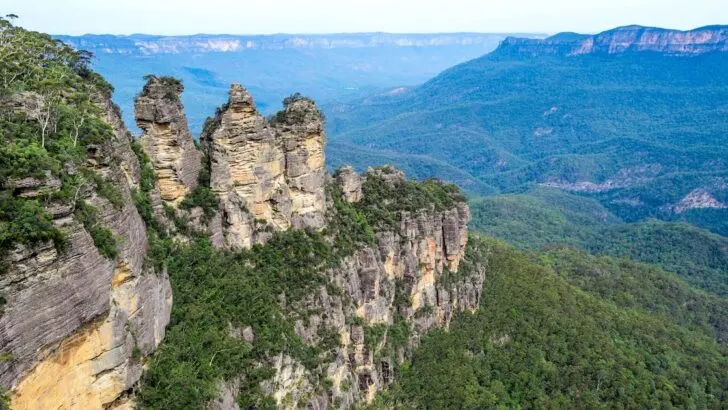It’s time to soak up a few interesting facts about the Three Sisters in the Blue Mountains.
Whether you have already arrived at this famous New South Wales landmark or you’re planning a trip soon, these facts should both surprise and impress you.
Knowing the history of a location can be the difference between an average day out and a story that you’ll tell to your friends and family for months to come.
I’ll begin with how the three rock towers formed, before explaining some interesting facts about the Three Sisters aboriginal legend.
I’ve also added some facts about great bush walks near the landmark and the epic, steel Giant Stairway nearby.
Disclosure: This post includes affiliate links. If you decide to click through and make a qualifying purchase, I will receive a small commission at no extra cost to you – thanks for your support.
QUICK INFORMATION
Best time to visit: January – June
Best place to stay: Katoomba
Getting around: Car hire, bus or taxi
Top Hotels Near the Three Sisters

Fairmont Resort & Spa (Leura) ££

Lilianfels Blue Mountains Resort and Spa (Katoomba) £££
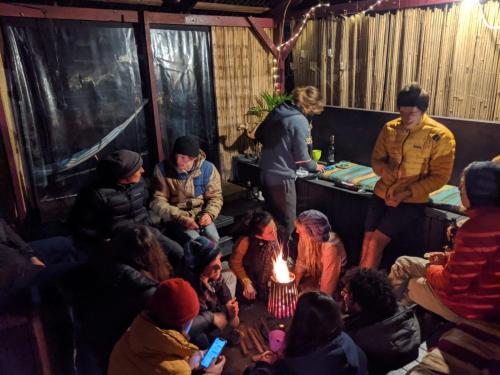
Flying Fox Backpackers (Katoomba) £
Where are the Three Sisters?
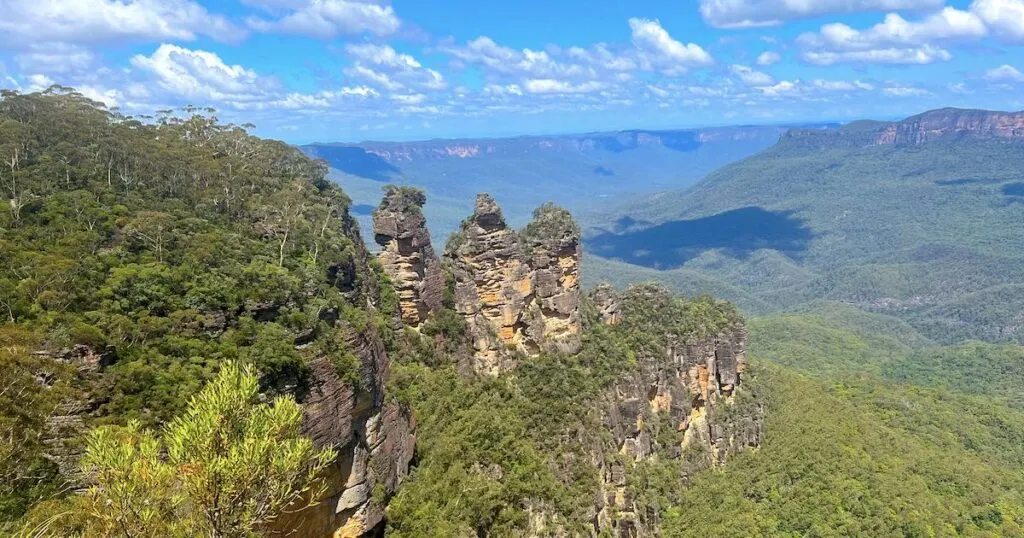
The Three Sisters are situated in the Blue Mountains in New South Wales, just outside of Sydney. They are on the north escarpment of Jamison Valley.
The location is easy to access from Sydney and the east coast of Australia.
The Three Sisters are on the outskirts of the town of Katoomba, which is one of the most popular places to stay in the Blue Mountains. If you’re staying in the town, the viewpoint of the landmark is within walking distance.
If you’re staying in Sydney, you can either take the train to Katoomba and make your way to Echo Point on foot.
Alternatively, book a tour. The benefit of taking a tour is that you can visit multiple sites in one day. It maximises your time in the Blue Mountains, especially if you have only planned for a day trip.
I’d suggest checking the availability of the most popular Blue Mountain tours on GetYourGuide well in advance because they often sell out:
- Sydney Blue Mountains Tour and Sunset: The Three Sisters (sunset), Wentworth Falls and a bush walk. Costs: 165 AUD
- Sydney Three Sisters and Leura Tour: The Three Sisters, Leura Village, Echo Point, Scenic World, Sydney Zoo. Costs: 99 AUD (entry fees excluded)
- Sydney Three Sisters and Wentworth Falls Tour: The Three Sisters and Wentworth Falls. Costs: 115 AUD
10 Interesting Facts About the Three Sisters in the Blue Mountains
1. The Three Sisters were formed 200 million years ago.
The Three Sisters were formed approximately 200 million years ago in a time called the Triassic period (basically, when dinosaurs began to become dominant over reptilian-type species).
The landscape of the Jamison Valley in the Blue Mountains was gradually worn down by wind, rain and rivers. This was relatively easy considering that the land was (and still is) made up of layered sediment from when the Blue Mountains were covered by the sea.
Eventually, volcanoes erupted through the crosswise layers of coal, sandstone and shale. This wound up forming three distinct, in-line boulders which we know now as the Three Sisters.
2. The Three Sisters is a declared Aboriginal Place.

The Three Sisters was the 98th place in the state of New South Wales to be named as an official Aboriginal Place.
It was given the title in 2014 due to its aboriginal history and legend.
3. The Three Sisters rocks have names.
According to aboriginal legend of the Three Sisters, the rocks have names.
From the tallest to the shortest, they are named Meehni, Wimlah and Gunedoo.
4. The Three Sisters have an interesting legend
The best-known story behind the Three Sisters is an Indigenous Australian Dreamtime Legend featuring three sisters.
You guessed it. The sisters were called Wimalah, Meeni and Gunedoo.
Wimalah, Meeni and Gunedoo were members of the Katoomba tribe. However, they were in love with three brothers from the neighbouring tribe, called Nepean.
Unfortunately, the Katoomba tribe banned marriage. As a way around the marriage ban, the brothers decided to kidnap the three sisters.
A battle broke out between the two tribes, ending in an elder of the Katoomba tribe turning the three sisters to stone to protect them from harm.
The elder’s plan was to turn them back to flesh and bone once the battle was finished. Unfortunately, he was killed in the battle, and no one could figure out how to reverse his actions after his death.
The three sisters remained captured in stone forever.
6. The tallest point of the Three Sisters is 922 metres high.
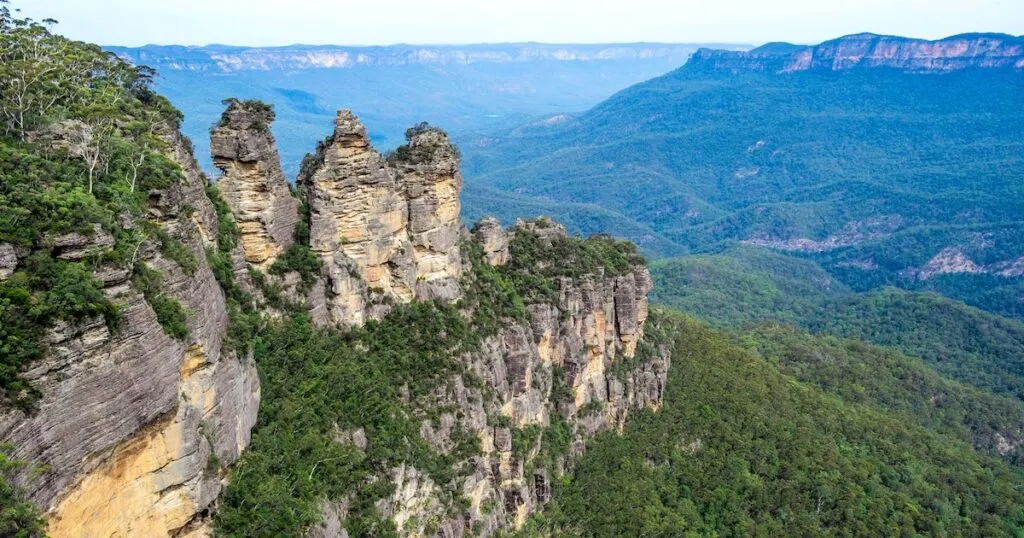
The tallest of the Three Sisters, Meehni, is 922 metres high.
Its sisters, descending in height from left to right from the viewpoint at Echo Point, are 918 metres and 906 metres high.
7. The Three Sisters will disappear someday.
One of the most interesting facts about the Three Sisters is that it’s believed that they will disappear eventually.
This won’t be a quick process. It will take place over years and years through the process of erosion.
The wind and rain will eventually shave down the three sandstone towers until they can’t be seen.
It’s likely that the surrounding Jamison Valley will also look very different by then due to the effects of erosion.
8. Echo Point gets up to 2 million visitors per year.
Echo Point, the best viewpoint of the Three Sisters and Jamison Valley, is a very popular tourist destination.
The lookout is estimated to get between 1.5 and 2 million visitors every year.
Arriving early in the day is the best way to beat the crowds.
9. The Three Sisters viewpoint has access to an epic staircase with 800 steps.
From the Echo Point viewpoint over the Three Sisters, there is a short trail winding to the left. After walking leisurely for five to 10 minutes on the trail, you will reach the Giant Stairway.
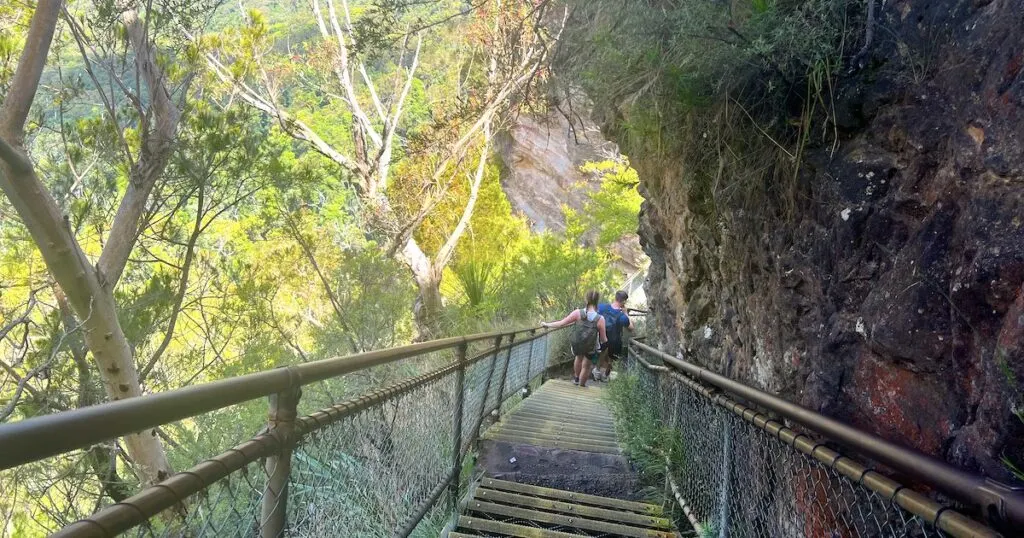
This manmade steel and stone stairway winds from the top of the cliff down 800 hair-rising steps. It has epic views over the Jamison Valley.
At the bottom of the staircase, there is a bush walk called The Federal Pass which takes around 1.5 hours to reach Katoomba Falls.
At Katoomba Falls, you can bathe in the freshwater waterfall. From here, you can also catch the Katoomba Scenic Railway back to Katoomba.
10. The best time to visit the Three Sisters is between January and June.
Try to visit the Three Sisters is during December January, February, March, April, May or June.
The busiest but best time to visit is between December and February, during the summer, when conditions are the warmest and least cloudy.
Low season is considered to be winter, between June and August, but there is a higher chance of cloud or rain covering the view of the Three Sisters.
Places to Visit Near the Three Sisters
- Leura Falls (bushwalk with waterfalls): Within walking distance.
- Katoomba town: Within walking distance.
- Katoomba Falls: Within walking distance.
- Scenic World (cable car attractions): Within walking distance
Resources for the Blue Mountains

Fairmont Resort & Spa (Leura) ££

Lilianfels Blue Mountains Resort and Spa (Katoomba) £££

Flying Fox Backpackers (Katoomba) £
For a small, boutique hotel, check out the availability for the Chalets at Blackheath located in Blackheath, near the Grand Canyon.
Getting around: Hiring a car is the easiest way to get around the Blue Mountains. Bus routes run between the main towns in the Blue Mountains. Taxi services are available but there is no Uber.
Tours: There are good tours of the Blue Mountains on GetYourGuide.
The Three Sisters are named after an aboriginal legend about three sisters who were turned to stone by an elder of their tribe to prevent them from being harmed in a battle with a neighbouring tribe.

